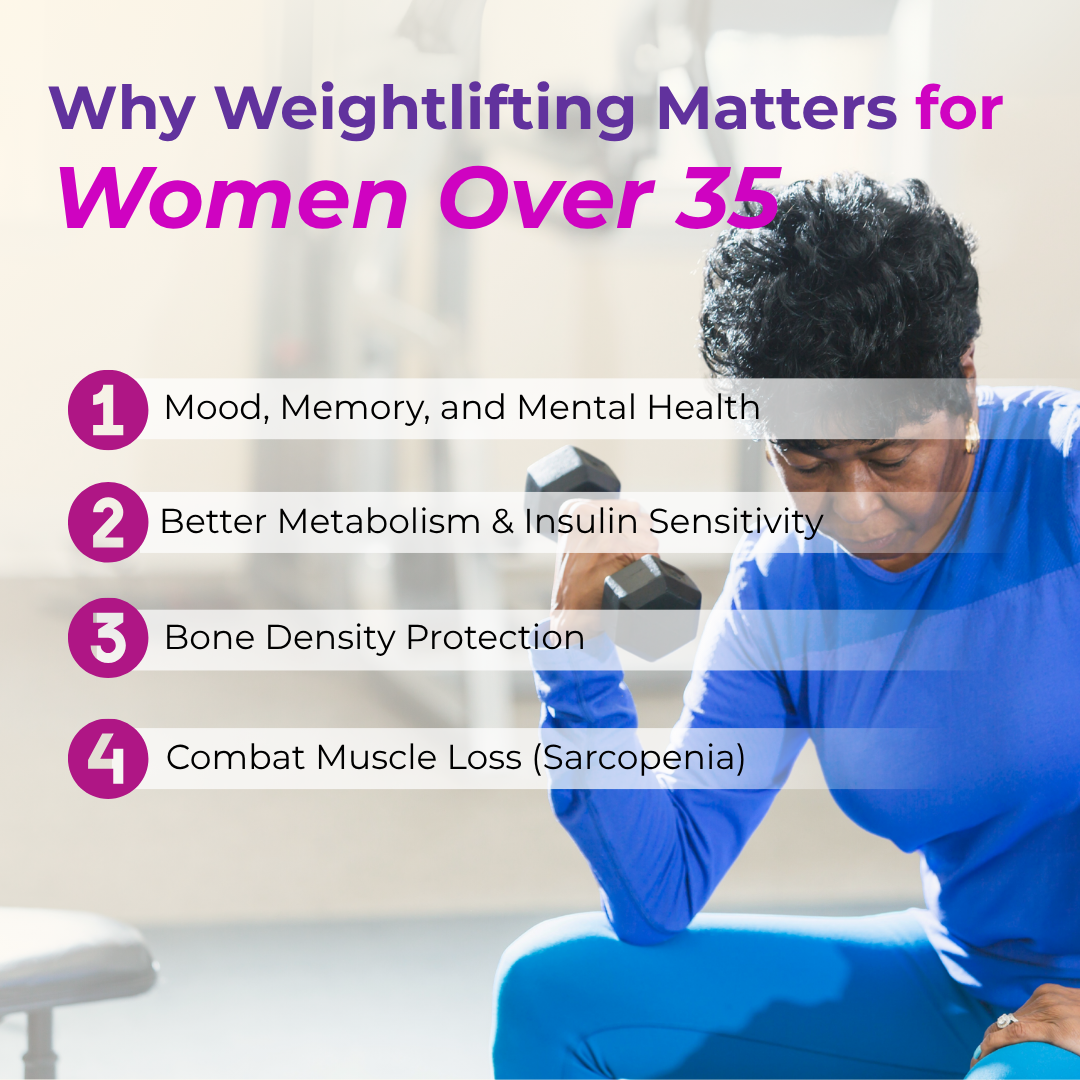CLICK TO SHOP OUR BLACK FRIDAY SALE!
*Excludes BioNude and subscriptions

If you’re a woman aged 35 and up, there’s a good chance you’ve heard some version of:
Spoiler alert: all of that is nonsense.
The truth is that strength training is one of the most powerful tools for women’s physical and mental health, especially from the age of 35 onward, when hormones begin to shift, bone density starts to decline, and muscle mass naturally drops off if we don’t do something about it.
Whether you’re 35 or 75, it’s never too late to start—and the benefits only stack with time.
Starting in your 30s, you begin to lose 3–8% of muscle mass per decade—unless you resistance train (Volpi et al., 2011). This loss accelerates after menopause, which is why women in midlife often feel like their metabolism is tanking.
Science-backed fix: Resistance training twice a week can significantly increase lean muscle mass and metabolic rate, helping to prevent fat gain and preserve function (Hunter et al., 2004).
Estrogen decline during perimenopause and menopause puts women at serious risk for osteopenia and osteoporosis. Resistance training (especially load-bearing exercises) stimulates osteoblast activity—aka the cells that build bone.
A 12-month study on postmenopausal women showed that lifting heavy weights improved bone density in the spine and femoral neck (Watson et al., 2018).
Lifting weights increases glucose uptake in muscles, improves insulin sensitivity, and boosts resting metabolic rate—vital for maintaining a healthy body composition, especially as hormone fluctuations affect insulin response.
Regular strength training can reduce insulin resistance and the risk of type 2 diabetes (Ibañez et al., 2005).
Weightlifting isn’t just for the body—it’s brain fuel. Resistance training improves BDNF (brain-derived neurotrophic factor), which supports memory and cognitive function. It also reduces symptoms of depression and anxiety—especially during hormonal transitions like perimenopause.
A meta-analysis found strength training to be as effective as antidepressants for many women with mild-to-moderate depression (Gordon et al., 2017).
Myth to bust: “I just need to tone.”
Truth: Toning = building muscle + reducing fat. You have to lift to do this.
Myth to bust: “Cardio burns more calories.”
Truth: Muscle burns calories all day long. Cardio stops when you stop.
Myth to bust: “I’m too old to lift heavy.”
Truth: You’re never too old. Women in their 60s and 70s have gained strength and reversed bone loss in studies (see: Watson et al., 2018).
Myth to bust: “It’s dangerous to start now.”
Truth: Weightlifting reduces fall risk, enhances independence, and improves quality of life.

Lorem ipsum dolor sit amet, consectetur adipiscing elit.
Lorem ipsum dolor sit amet, consectetur adipiscing elit.
Lorem ipsum dolor sit amet, consectetur adipiscing elit.
Lorem ipsum dolor sit amet, consectetur adipiscing elit.
Disclaimer: The information provided above is intended for educational and informational purposes only. Statements made have not been evaluated by the FDA nor are they intended to treat or diagnose. Any health concerns should be discussed and evaluated by your primary health care provider.
Parlor Games, LLC ● kate@parlor-games.com ● 5304 River Rd N Ste B ● Keizer OR 97303
Disclaimer: The information provided above is intended for educational and informational purposes only. Statements made have not been evaluated by the FDA nor are they intended to treat or diagnose. Any health concerns should be discussed and evaluated by your primary health care provider.
28 Day Challenge Subscription Details

We ship you a 28 day supply of Silky Peach Cream for only $29 (more than 25% off our normal price) when you sign up for Subscribe & Save.
Follow the directions we include in the package and apply Silky Peach cream on your tender bits for 28 days.

Decision Day:
5 days before your subscription rebills, we’ll send you an email reminder with a link. If you decide Silky Peach is nice but not your thing… you can click that link and cancel your subscription without even talking to anyone. No hassle — no questions asked.
If you are like 72% of our Silky Peach customers, you’ll love it and can't imagine life without it. In that case, do nothing, and we’ll welcome you to the Parlor Games family and ship Silky Peach Cream to your door step every month for the same discounted price of $29 — locked in for as long as you remain a subscriber.

Important note about our easy-breezy subscriptions:
We know that some companies make it hard to cancel a subscription — that’s not us. Our mission is to save the world — one vagina at a time! If you decide you don’t need Estriol as an ongoing solution for dryness, incontinence, UTIs and keeping sex fun and comfortable again, we understand. Five days before we ship your next order, you'll receive an email with a link to cancel right there in the message.
No hunting, no searching, we got you. Respect is where it’s at.
FYI – Estriol is beneficial for skin integrity and mucous membranes. It’s great for vaginal atrophy and also amazing for use on the face and neck. Applying a small amount — about 1 pump — can help build the collagen and plump up the cells to reduce wrinkles. Who knew!!
OUR HAPPINESS GUARANTEE
We want you to feel safe and confident trying any of our products. That's why we promise 100% money-back guarantee on the purchase price of the first bottle of any of our products. Balancing hormones DOES take some time, so please try it for 28 days. If after 28 days you are unhappy, or the product just hasn't worked for you, simply contact us and we'll process a refund of your full purchase price upon receipt. Sorry, shipping fees are not refundable.